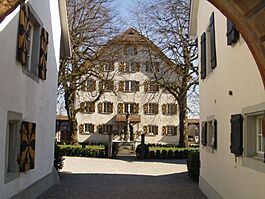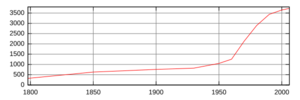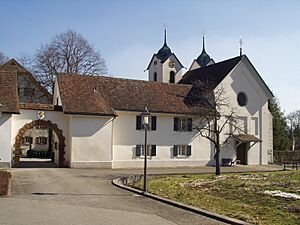Böttstein facts for kids
Quick facts for kids
Böttstein
|
||
|---|---|---|
 |
||
|
||
| Country | Switzerland | |
| Canton | Aargau | |
| District | Zurzach | |
| Area | ||
| • Total | 7.43 km2 (2.87 sq mi) | |
| Elevation | 356 m (1,168 ft) | |
| Population
(Dec 2020 )
|
||
| • Total | 3,982 | |
| • Density | 535.9/km2 (1,388.1/sq mi) | |
| Postal code |
5315 (Böttstein)
5314 (Kleindöttingen) |
|
| Surrounded by | Döttingen, Klingnau, Leuggern, Mandach, Villigen, Würenlingen | |
Böttstein is a small town, also called a municipality, located in the canton of Aargau in Switzerland. It is part of the Zurzach district.
Contents
History of Böttstein
Some very old items from the La Tène culture (an ancient Iron Age culture) have been found near Böttstein. The modern village of Böttstein was first mentioned in records in 1087. Back then, it was called Botistein.
From the 11th to the 13th centuries, Böttstein was home to the "lords of Böttstein." These were powerful families who ruled over the village. Other nearby villages were under the control of the Knights Hospitaller, a famous knightly order, from their house in Leuggern.
After the Aargau region was taken over in 1415, Böttstein became part of the County of Baden. The right to govern the village changed hands about ten times. Then, in 1606, the von Roll family from Uri bought it. Between 1615 and 1617, they built a new castle. This castle was a mix of late-Gothic and early Baroque styles, and it even had its own chapel.
In 1674, the property went to the Schmid family through marriage. They ruled the village until 1798 and lived in the castle until 1893. The castle's chapel, dedicated to St. Anthony, was beautifully decorated. It had amazing stucco work (a type of plaster decoration) created by artists from northern Italy. In 1816, Böttstein became its own separate municipality, splitting from the larger municipality of Leuggern.
For a long time, the main jobs in Böttstein were farming, growing grapes for wine (viticulture), and making things by hand (handicrafts). In the late 1800s, the timber (wood) industry grew along the Aare river. This created many new jobs. Because of these jobs, the small village of Kleindöttingen grew very quickly. Even though Böttstein has its own businesses, like a particle board factory (from 1970-1994) and furniture factories, many people who live there travel to other towns for work.
Geography and Nature
Böttstein covers an area of about 7.41 square kilometers (2.86 square miles). A big part of this land is used for farming (34%). Another large part (35.1%) is covered by forests. About 20.8% of the land has buildings or roads. Rivers and lakes make up 9.2% of the area.
Most of the built-up areas are homes and other buildings (8.9%), industrial buildings (3.6%), and roads (4.0%). The forests are mostly dense woods, with some smaller groups of trees. The farmland is used for growing crops and for pastures where animals graze.
The municipality is located on the left bank of the Aare river. It's just a few kilometers from where the Aare river joins another river (its confluence). Böttstein includes the main villages of Böttstein and Kleindöttingen. It also has two smaller settlements called hamlets: Eien and Burlen.
Böttstein's Coat of Arms
The blazon (official description) of Böttstein's municipal coat of arms is Or Frete Gules. This design comes from the old coat of arms of the Counts of Böttstein, who once ruled the area.
People and Population
Böttstein has a population of about 3,762 people (as of 2022). About 39.2% of the people living in Böttstein are from other countries. Over the last ten years, the population has grown a little, by about 1.1%.
Most people in Böttstein (80.3%) speak German. The next most common languages are Italian (6.3%) and Albanian (4.3%).
Here's a look at the age groups in Böttstein (as of 2008):
- Children (0-9 years old): 9.8%
- Teenagers (10-19 years old): 13.3%
- Young adults (20-29 years old): 13.3%
- Adults (30-39 years old): 11.6%
- Adults (40-49 years old): 16.3%
- Adults (50-59 years old): 15.2%
- Seniors (60-69 years old): 10.8%
- Seniors (70-79 years old): 7.0%
- Seniors (80-89 years old): 2.4%
- Seniors (90 and older): 0.3%
In 2000, about 52.2% of the homes in Böttstein were owned by the people living in them. This means they didn't pay rent. In 2008, there were 433 single-family homes in Böttstein. There were also only 4 empty apartments, which means almost all homes were occupied.
In the 2007 federal election, the most popular political party was the SVP, which received almost half of the votes (49.84%). Other popular parties were the CVP (20.11%), the FDP (10.67%), and the SP (10.47%).
Here is how the population of Böttstein has changed over time:
| year | population |
|---|---|
| 1799 | Böttstein 168
Kleindöttingen 96 |
| 1850 | together 629 |
| 1888 | 536 |
| 1900 | 760 |
| 1950 | 1,051 |
| 2000 | 3,648 |
Important Historical Sites
Böttstein has some very important historical buildings. The old oil press and sawmill at Schlossweg 2 are considered heritage sites of national significance. This means they are very important to Switzerland's history and culture. The castle chapel is also a national heritage site. The entire village of Böttstein is recognized as part of the Inventory of Swiss Heritage Sites, showing its special historical value.
Economy and Jobs
In 2012, there were 1,671 people working in Böttstein.
- The primary sector (like farming) had 52 workers in 14 businesses.
- The secondary sector (like manufacturing and factories) had 743 workers in 51 businesses.
- The tertiary sector (like services, shops, and offices) had 876 jobs in 134 businesses.
In 2013, a very small number of people (0.5%) in Böttstein received social assistance (help from the government).
Many people who live in Böttstein travel to other towns for work. In 2000, about 76.7% of residents worked outside Böttstein. At the same time, 722 people came into Böttstein for work. For getting to work, 15.4% of people used public transportation, and 55.3% used a private car.
Religion in Böttstein
Based on the 2000 census:
- 2,087 people (57.2%) were Roman Catholic.
- 661 people (18.1%) belonged to the Swiss Reformed Church (a Protestant church).
- A small number of people (about 0.19%) belonged to the Christian Catholic faith.
Education
In Böttstein, about 62.2% of adults (aged 25-64) have completed more than just basic schooling. This includes either non-mandatory upper secondary education or higher education like university or a Fachhochschule (a type of professional university).
In the 2008/2009 school year, there were:
- 261 students attending primary school (for younger children).
- 202 students attending secondary school (for older children and teenagers) in the municipality.
See also
 In Spanish: Böttstein para niños
In Spanish: Böttstein para niños







